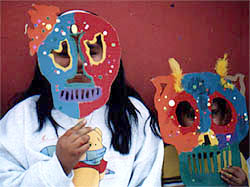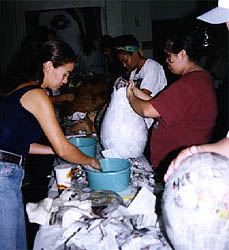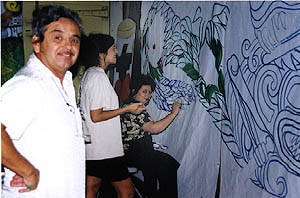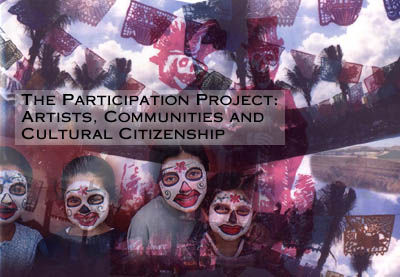Participation Project Timeline
- Phase Two, continued
| May 26 Slide
Lecture and Discussion with artist Yong Soon Min at Getty Research Institute
Lecture Hall/Getty Center. This lecture entitled, "US AMIN" covers issues
and concerns associated with issues of identity and hybridity. The lecture covers a
diverse range of media and introduces art that initiates contact between local
communities. |
In addition to the Encuentros, a focus group is held for
area residents (non-artist and non-activist) on June 13th at the Boyle Heights
Senior Center. Participants—youth, middle aged, and seniors—discuss the cultural
assets of the East LA community and map the results in a half-day workshop, citing a wide
range of activities, organizations, murals, parks, buildings in the project area.
| "What are some of the
things that you value most about your neighborhood? If you had to move, what are some of
the things that you would miss most? What are some
of the things/events/places in your neighborhood that you find inspiring, beautiful,
moving? What would your neighborhood be like without these things? Do you think that art
and culture are part of everyday experience in your neighborhood?"
|

|
| Summer 1998 Self Help Graphics sponsors two
panels and a film screening that include a discussion of Self Help/Proyecto
Pastoral/Research Institute on the Participation Project. The first panel explores the
re-imagining of the East LA community by several artists and architects. The second
profiles the social-change intent of particular artists, starting with the work of Mexican
muralist David Alfaro Siqueiros and continuing to the present. |
IV. Phase Three:
Community Artmaking Project Selection and Implementation
Summer and Fall ’98
The Core Leadership Team selects the yearly festivals of Dia de Los Muertos (Day of the Dead) at Self Help
Graphics and Dia de la Virgen/Las Posadas (Virgin of Guadalupe’s Feast Day and the
traditional Christmas procession Las Posadas) at Proyecto Pastoral as the culminating
events for a series of participatory workshops to take place September through December
1998.
| Since these festivals are
already successful community events, the workshops function to enhance these gatherings
and to bring together people in a neighborhood artmaking activity who may not have
participated before. The workshops include paper mache, papel
picado (traditional Mexican paper cutting), paper flower making, mural making, teatro
(theatre) workshops, pan de muerto (traditional Day of the Dead breadmaking), sugar skull
decorating, pinata-making, music and more. Culminating
events—in early November and in mid-December-- include neighborhood
processions that utilize the artwork constructed during the workshops, plus additional
artmaking activities. Also offered are evening presentations on the culture and history
related to the Day of the Dead and Dia de la Virgen/Las Posadas traditions.
|

|
 |
Documentation and assessment
process parallels the workshop activity during this phase. Getty Research Institute and
Urban Institute project staff conduct interviews with participants and artists, as well as
collect other information related to the project area to include in the final report. |
V. Phase Four:
Culminating Report Winter/Spring ‘99
Report will describe entire process, documentation of the
artist-team process from experiment proposals to production, plus critical essays and
findings of assessment process.
"One of the things that make modern life
worth living is the enhanced opportunities it offers us -- and sometimes even forces on us
-- to talk together, to reach and understand each other. We need to make the most of these
possibilities; they should shape the way we organize our cities and our lives."
Marshall Berman, from All That is Solid Melts Into
Air: The Experience of Modernity
<< previous
|



